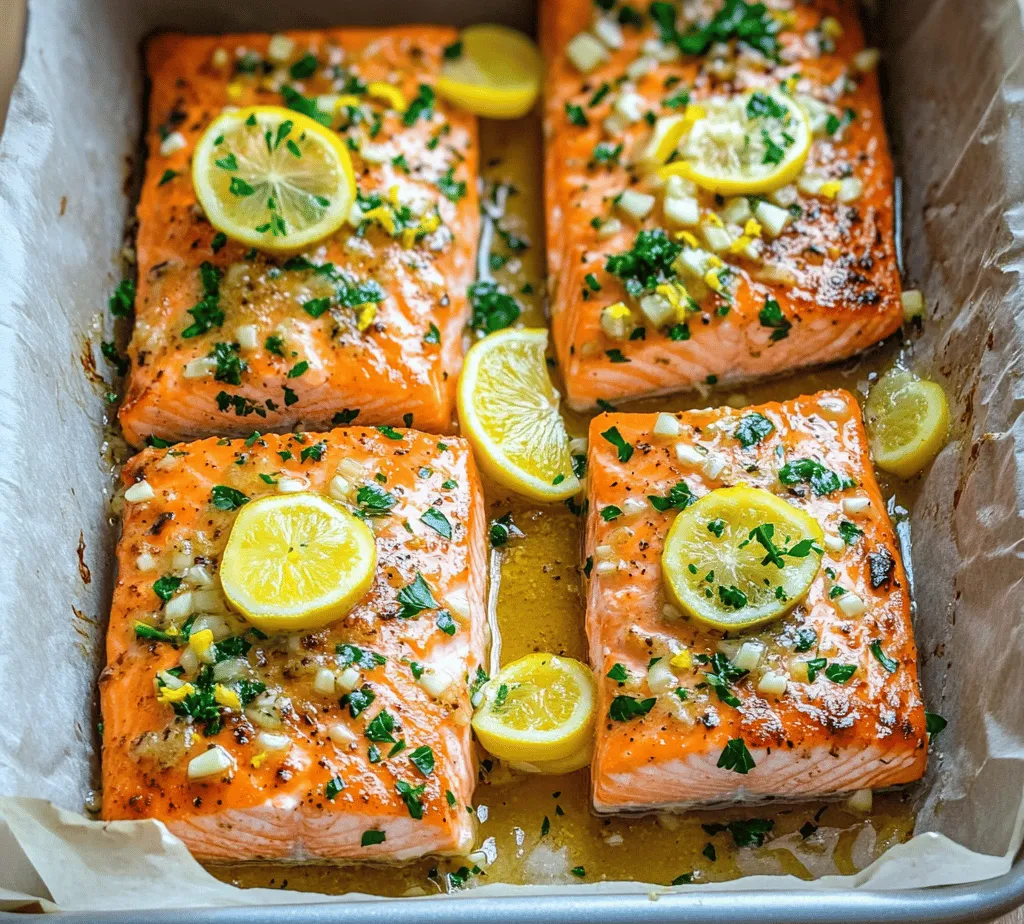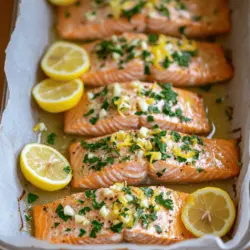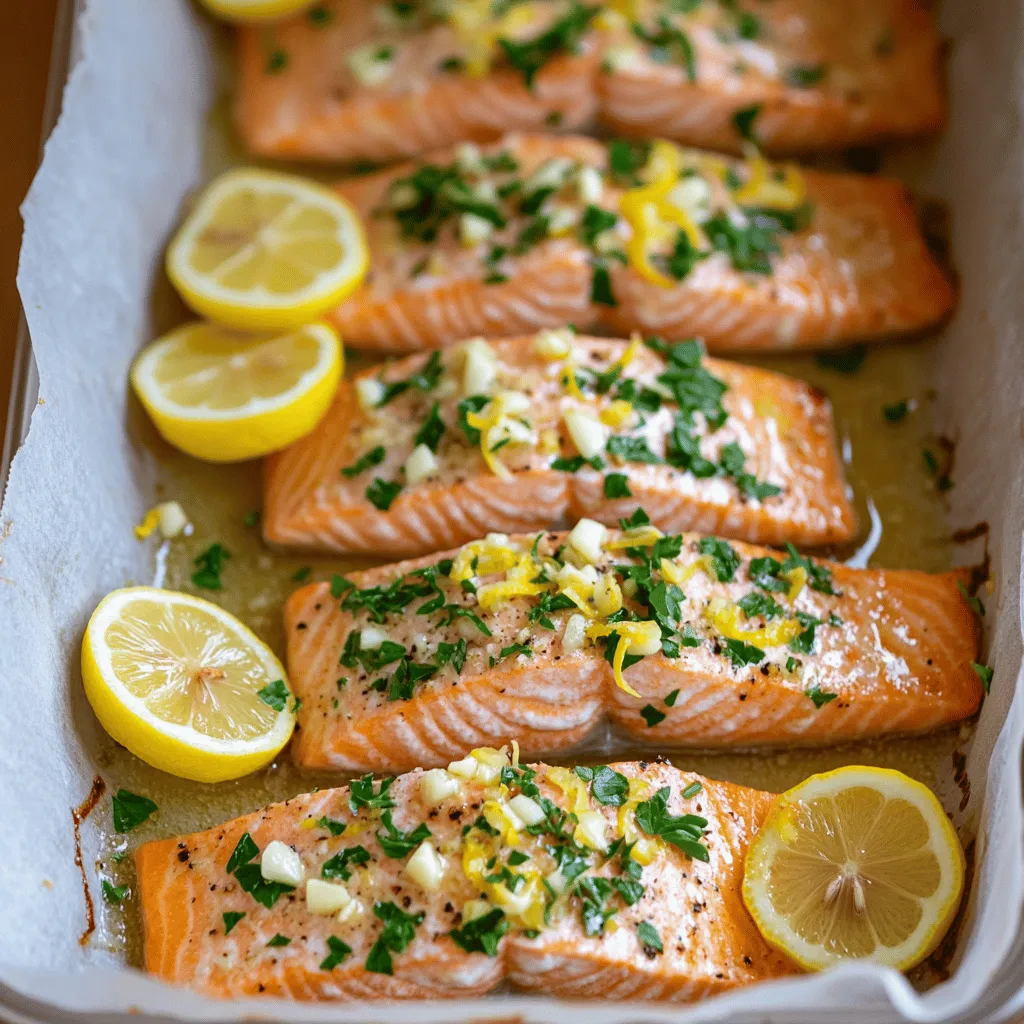Introduction
The allure of perfectly baked salmon lies in its delicate flavor and tender texture. When combined with the rich, aromatic essence of garlic butter, it transforms into a culinary delight that is both simple and exquisite. This article explores the step-by-step process of making the best garlic butter baked salmon, highlighting its health benefits, flavor profile, and tips for achieving the perfect result. Whether you are serving it for a weeknight dinner or a special occasion, this dish promises to impress.
Salmon is a versatile fish that can be prepared in various ways, but baking it with garlic butter elevates it to a whole new level. The method ensures that the salmon remains moist and flaky while infusing it with the robust flavors of garlic and butter. As you embark on this culinary journey, you will discover that this recipe is not just about cooking fish; it’s about creating a memorable meal that brings joy to the table.
Understanding Salmon: A Nutritional Powerhouse
Salmon is often heralded as a superfood, and for good reason. This fish is packed with nutritional benefits that make it an excellent addition to any diet.
Omega-3 Fatty Acids and Their Importance
One of the standout features of salmon is its high content of omega-3 fatty acids. These essential fats are crucial for maintaining optimal health, as they play a significant role in reducing inflammation, lowering blood pressure, and promoting heart health. Omega-3 fatty acids are also known to support brain function, making salmon a smart choice for both physical and mental well-being. Incorporating salmon into your diet can help you meet your omega-3 needs, which are particularly important since the body cannot produce these fats on its own.
Rich Source of Protein and Essential Vitamins
In addition to being rich in omega-3s, salmon is an excellent source of high-quality protein. Protein is vital for building and repairing tissues, and it plays a crucial role in producing hormones and enzymes. Each serving of salmon provides a substantial amount of protein, making it a satisfying meal option that can help keep you feeling full and energized.
Salmon is also loaded with essential vitamins, including vitamin B12, which is important for nerve function and the production of DNA and red blood cells. It contains significant amounts of vitamin D, which supports bone health and immune function. Other beneficial nutrients found in salmon include selenium, a powerful antioxidant, and potassium, which helps regulate blood pressure.
Benefits for Heart Health and Brain Function
The combination of omega-3 fatty acids, high-quality protein, and essential vitamins makes salmon a heart-healthy choice. Regular consumption of salmon has been linked to a reduced risk of heart disease and stroke. The beneficial fats in salmon can help lower levels of triglycerides and increase levels of good cholesterol (HDL), contributing to overall cardiovascular health.
Moreover, the nutrients in salmon are believed to enhance brain function. Studies suggest that diets rich in fatty fish, such as salmon, may reduce the risk of cognitive decline and improve mood. By incorporating this nutritional powerhouse into your meals, you can enjoy a delicious dish while reaping its many health benefits.
Choosing the Right Salmon for Your Recipe
When it comes to preparing garlic butter baked salmon, the type of salmon you choose can significantly impact the flavor and texture of the dish. Understanding the different varieties available can help you make an informed decision.
Wild-Caught vs. Farmed Salmon
One of the primary distinctions in salmon is between wild-caught and farmed varieties. Wild-caught salmon is typically considered superior in taste and nutritional value. This type of salmon is sourced from natural habitats, where it feeds on a varied diet of other fish and marine life. As a result, wild-caught salmon tends to have a firmer texture and a more robust flavor profile.
On the other hand, farmed salmon is raised in controlled environments, often resulting in a milder flavor and softer texture. While farmed salmon is often more readily available and can be less expensive, it may have a different nutritional profile, including higher fat content and lower levels of certain nutrients.
Flavor Profiles and Textures of Different Salmon Varieties
Within the categories of wild-caught and farmed salmon, you will find several popular varieties, each with its unique flavor and texture:
- King Salmon (Chinook): Known for its rich, buttery flavor and high-fat content, king salmon is often regarded as the finest variety. Its luxurious taste makes it a favorite for special occasions.
- Sockeye Salmon: With its vibrant red color and bold flavor, sockeye salmon is another popular choice. It has a firmer texture and is often preferred for grilling or baking.
- Coho Salmon: Coho salmon offers a milder flavor compared to sockeye and king salmon. It has a moderate fat content and is versatile for various cooking methods.
- Pink Salmon: Generally smaller and lower in fat, pink salmon is often used in canned products. However, it can still be delicious when cooked fresh.
- Chum Salmon: While not as popular as the other varieties, chum salmon has a mild flavor and is often used in smoked products.
Tips for Selecting Fresh Salmon at the Market
When shopping for salmon, freshness is key to achieving the best flavor and texture. Here are some tips to help you select the freshest salmon:
1. Look for Clear Eyes: Fresh salmon should have clear, bright eyes. Cloudy or dull eyes can indicate that the fish is not fresh.
2. Check the Smell: Fresh salmon should have a mild, ocean-like scent. If the fish smells overly fishy or off-putting, it’s best to avoid it.
3. Examine the Flesh: The flesh of fresh salmon should be firm and moist. It should spring back when pressed and have a vibrant color without any discoloration or browning.
4. Ask About Sourcing: If possible, inquire about where the salmon was sourced. Knowing whether it’s wild-caught or farmed can help you choose the best option for your recipe.
5. Buy Whole or Fillets: Depending on your cooking preferences, you can buy whole salmon or fillets. If you choose fillets, look for uniform thickness to ensure even cooking.
Essential Ingredients for Garlic Butter Baked Salmon
Now that you understand the nutritional benefits of salmon and how to choose the right variety, let’s explore the essential ingredients for our garlic butter baked salmon recipe. Each component plays a crucial role in enhancing the overall flavor and presentation of the dish.
Importance of Unsalted Butter for Flavor Control
Unsalted butter is the star of this recipe. Using unsalted butter allows you to have complete control over the saltiness of the dish. Salted butter can vary in sodium content, which might lead to an overly salty result. By using unsalted butter, you can adjust the seasoning to your preference, ensuring a perfectly balanced flavor. The richness of the butter not only adds a velvety texture to the salmon but also enhances the savory notes of the garlic.
The Role of Garlic in Enhancing Taste
Garlic is a quintessential ingredient in many culinary masterpieces, and for good reason. Its robust flavor enhances the taste of the salmon without overpowering it. When roasted, garlic becomes mellow and sweet, creating a delightful contrast to the richness of the butter and the salmon. Fresh garlic cloves are recommended for this recipe, as they provide a vibrant flavor that dried garlic simply cannot match. The combination of garlic and butter creates an aromatic base that infuses the salmon with an irresistible essence as it bakes.
Fresh Lemon Juice and Zest: Balancing Flavors
To achieve a well-rounded flavor profile, fresh lemon juice and zest are essential. The acidity of the lemon juice cuts through the richness of the butter and salmon, providing a bright, refreshing contrast. Lemon zest, on the other hand, adds an extra layer of citrus flavor, enhancing the overall aroma of the dish. The combination of garlic and lemon not only elevates the taste but also adds a beautiful brightness, making the dish feel lighter and more vibrant.
The Impact of Fresh Herbs on Presentation and Taste
Fresh herbs are the finishing touch that can elevate your garlic butter baked salmon from ordinary to extraordinary. Herbs such as parsley, dill, or thyme not only add a pop of color to the dish but also contribute nuanced flavors that complement the salmon beautifully. Parsley offers a mild, fresh taste that balances the richness, while dill provides a slightly sweet and herbaceous flavor that pairs perfectly with fish. Thyme adds an earthy note that brings depth to the dish.
Incorporating fresh herbs not only enhances the taste but also makes the presentation visually appealing, inviting your guests to dig in and enjoy.
—
In the following sections, we will delve deeper into the step-by-step instructions for preparing this delectable garlic butter baked salmon recipe, share some valuable tips for achieving the best results, and address common questions you may have as you embark on this culinary adventure. Stay tuned for a detailed guide that will help you create a dish that is sure to impress!

Step-by-Step Instructions for Preparing Garlic Butter Baked Salmon
If you’re ready to indulge in a dish that beautifully melds freshness with rich flavors, follow this detailed guide to prepare the BEST Garlic Butter Baked Salmon.
Preheating the Oven and Preparing the Baking Dish
Begin your culinary adventure by preheating your oven to 375°F (190°C). This temperature is ideal for allowing the salmon to cook evenly while retaining its natural juices. While the oven warms up, grab a baking dish or a rimmed baking sheet lined with parchment paper. This not only prevents sticking but also makes for an easier cleanup afterward. Lightly grease the parchment paper with cooking spray or a drizzle of olive oil to ensure that the salmon fillets slide out seamlessly after baking.
Melting the Butter and Infusing it with Garlic
Next, take 1/2 cup of unsalted butter and melt it in a small saucepan over low heat. Unsalted butter is preferred as it allows you to control the saltiness of the dish better. Once the butter has melted, add 4 cloves of minced garlic to the pan. Cooking the garlic gently in the melted butter for about 1-2 minutes will infuse the butter with a fragrant garlic aroma. Be cautious not to let the garlic brown, as this can lead to a bitter taste. Stir occasionally to ensure the garlic is evenly cooked and aromatic.
Combining Flavors with Lemon and Parsley
After the garlic has infused into the butter, it’s time to elevate the flavor profile. Remove the saucepan from heat and stir in the juice of one fresh lemon. The acidity from the lemon not only brightens the dish but also cuts through the richness of the butter. Next, finely chop a handful of fresh parsley (about 2 tablespoons) and mix it into the garlic butter. The parsley adds a vibrant color and fresh flavor that complements the fish beautifully.
Properly Placing and Coating the Salmon Fillets
Now, it’s time to prepare the star of the dish: the salmon fillets. Place 4 salmon fillets, skin-side down, on the prepared baking dish. If you prefer skin-on salmon, it will help retain moisture and flavor during baking. Using a brush or a spoon, generously coat each fillet with the garlic butter mixture, ensuring even coverage. If you have any remaining garlic pieces, scatter them over the salmon for an extra punch of flavor. For an added touch, season the fillets with a pinch of salt and black pepper to enhance their natural taste.
Baking the Salmon to Perfection
With the salmon coated and seasoned, place the baking dish in the preheated oven. Bake the salmon for 12-15 minutes, or until the fish is cooked through and flakes easily with a fork. The exact baking time will depend on the thickness of your fillets; thinner pieces will cook more quickly, while thicker cuts will require a little more time. As a general rule, aim for an internal temperature of 145°F (63°C) to ensure food safety.
Guidelines for Checking Doneness
To check if your salmon is done, gently press the top of the fillet with a fork or your finger. If it flakes easily and has a slightly opaque appearance, it’s ready to be taken out of the oven. Additionally, you can use an instant-read thermometer to check the internal temperature. Once cooked, remove the salmon from the oven and allow it to rest for a couple of minutes before serving. This resting period allows the juices to redistribute, ensuring a moist and tender final product.
Serving Suggestions for Garlic Butter Baked Salmon
Now that your garlic butter baked salmon is ready, it’s time to think about how to serve it. This dish is incredibly versatile and can be paired with a variety of sides and garnishes to create a complete meal.
Suggested Side Dishes that Pair Well with Salmon
1. Roasted Vegetables: A medley of seasonal vegetables such as asparagus, bell peppers, and carrots drizzled with olive oil and roasted until caramelized complements the richness of the salmon.
2. Rice or Quinoa: A bed of fluffy rice or quinoa can absorb the delicious garlic butter sauce, providing a satisfying and wholesome base for the dish.
3. Mashed Potatoes: Creamy mashed potatoes flavored with garlic or herbs can serve as a comforting side that pairs beautifully with the flaky salmon.
4. Green Salad: A light salad with mixed greens, cherry tomatoes, and a lemon vinaigrette can bring a refreshing contrast to the rich flavors of the salmon.
Creative Garnish Options for an Appealing Presentation
To make your dish visually appealing, consider adding garnishes. A sprinkle of fresh parsley or dill on top of the salmon enhances its presentation and adds a fresh flavor. You might also add lemon wedges on the side, which allows guests to squeeze extra juice over their portion. For a touch of elegance, use edible flowers or microgreens to decorate the plate.
Wine Pairings That Enhance the Dining Experience
When it comes to pairing wine with garlic butter baked salmon, consider a crisp white wine. A Sauvignon Blanc or a Pinot Grigio complements the dish’s flavors without overpowering the delicate taste of the salmon. If you prefer red wine, a light-bodied Pinot Noir can also work well, bringing out the richness of the butter without clashing with the fish.
Storing and Reheating Leftover Garlic Butter Baked Salmon
If you find yourself with leftovers, don’t worry—this salmon is just as delicious the next day! Proper storage is key to maintaining its flavor and texture.
How to Store Cooked Salmon for Freshness
First, allow the salmon to cool to room temperature before storing it. Wrap the fillets tightly in plastic wrap or aluminum foil, or place them in an airtight container. For optimal freshness, store the salmon in the refrigerator, where it can last for up to 3 days. If you want to keep it for a longer period, consider freezing it. Wrapped tightly in plastic wrap and then placed in a freezer-safe bag, baked salmon can be frozen for up to 3 months.
Techniques for Reheating Without Compromising Flavor and Texture
When it’s time to reheat your leftover salmon, you’ll want to do so gently to prevent it from drying out. The best method is to use the oven. Preheat your oven to 275°F (135°C), place the salmon on a baking sheet, and cover it loosely with foil. Heat for about 10-15 minutes, or until warmed through. Alternatively, you can reheat the salmon in a microwave, but use a lower power setting and cover it with a damp paper towel to retain moisture. Reheating in smaller increments, checking for doneness, will help ensure the salmon remains succulent.
Conclusion
Garlic butter baked salmon is a delightful and nutritious dish that combines simplicity with gourmet flavor. By following the outlined steps and understanding the nuances of the ingredients, anyone can recreate this restaurant-quality meal at home. Not only is it quick to prepare, but it also offers a wealth of health benefits, making it a staple for any home cook looking to elevate their dinner repertoire. Embrace the flavors of garlic and butter, and enjoy the succulent taste of perfectly baked salmon, worthy of any dining table. This dish is not only a feast for the taste buds but also an opportunity to gather loved ones around the table, creating memorable moments over a shared meal. So, gather your ingredients and get ready to impress your friends and family with this flavorful culinary masterpiece.


